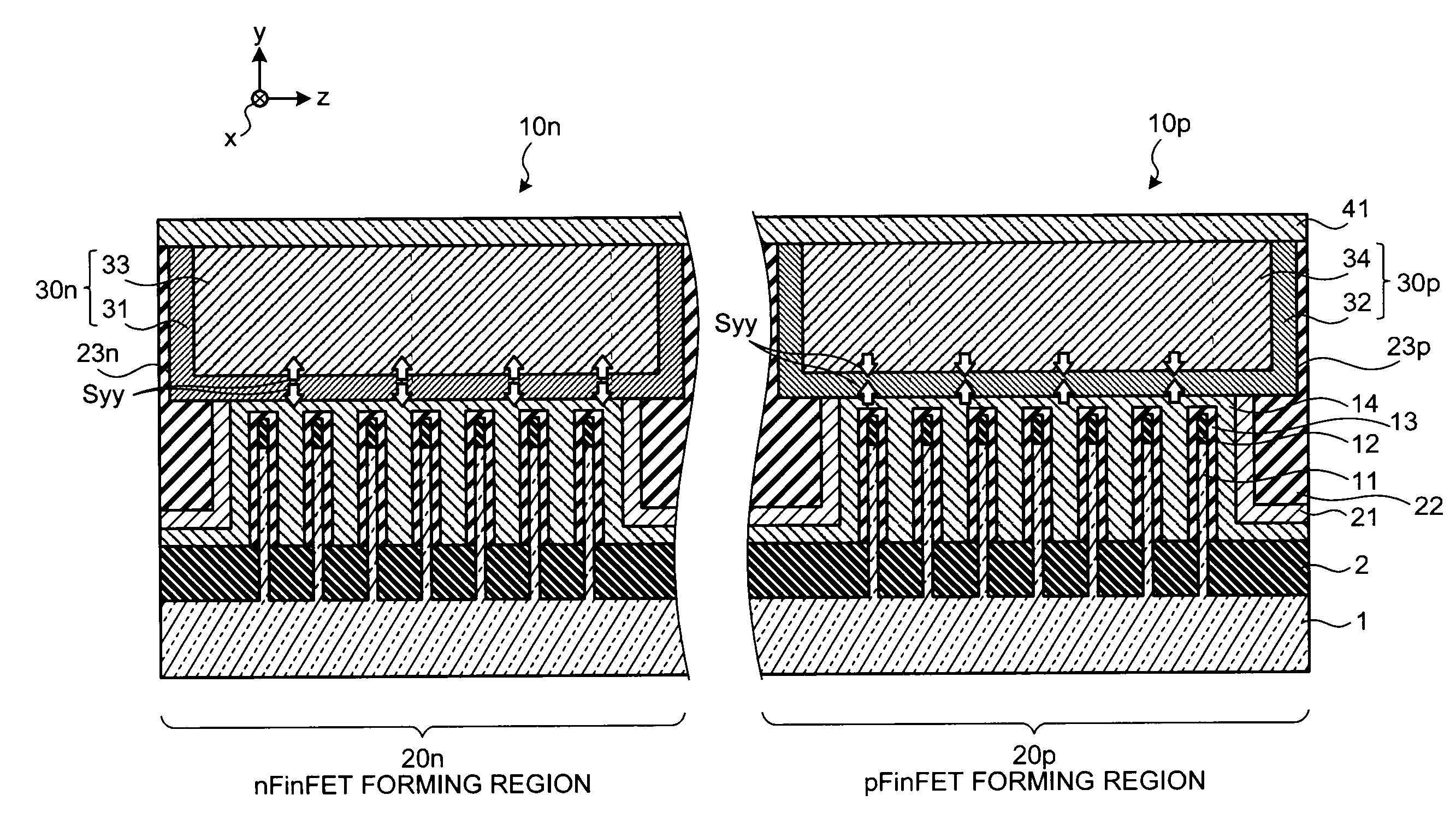Semiconductor device and manufacturing method thereof
a technology of semiconductors and semiconductors, applied in the direction of semiconductor devices, electrical devices, transistors, etc., can solve the problem that the carrier mobility in the channel of finfet has not been improved
- Summary
- Abstract
- Description
- Claims
- Application Information
AI Technical Summary
Problems solved by technology
Method used
Image
Examples
first embodiment
[0022]As explained above, in the first embodiment, the gate plugs 30n and 30p having lamination structures of the stress application layers 31 and 32, and the plug layers 33 and 34 are provided on the gate electrode 14. Therefore, compressive stress (in the case of the nFinFET 10n) or tensile stress (in the case of the pFinFET 10p) corresponding to a difference between a first difference and a second difference, wherein the first difference is a difference between the linear expansion coefficients at the temperature of forming the stress application layers 31 and 32 and the room temperature, and the second difference is a difference between the linear expansion coefficients at the temperature of forming the materials constituting the fins 11 and the room temperature, can be applied from the height direction (the y-axis direction) of the fins 11. In addition to this, the plug layers 33 and 34 having larger Young's modulus than that of the material constituting the fins 11 can play th...
second embodiment
[0038]In the second embodiment, in the case of the nFinFET, the stress application layer 61 is also configured by a material of which a difference between linear expansion coefficients at a temperature of forming the stress application layer 61 and the room temperature is smaller than a difference between linear expansion coefficients of a material constituting the fins 11 at a temperature of forming the stress application layer 61 and the room temperature.
[0039]In the case of the pFinFET, the stress application layer 61 is configured by a material of which a difference between linear expansion coefficients at a temperature of forming the stress application layer 61 and the room temperature is larger than a difference between linear expansion coefficients of a material constituting the fins 11 at a temperature of forming the stress application layer 61 and the room temperature.
[0040]Preferably, the plug layer 62 constituting the gate plugs 30n and 30p is formed by a material having ...
third embodiment
[0053]In the third embodiment, the polycrystalline silicon film 63 is formed on the gate electrode 14. The gate plug 30n (the plug layer 64) is formed by a metal material on this polycrystalline silicon film 63. The formed result is heat treated to silicify only the upper part of the gate electrode 14 of the polycrystalline silicon film 63, thereby forming the silicide film 65 having expanded volume. As a result, compressive stress can be applied to the fins 11 in the y-axis direction. Therefore, carrier mobility in the channel can be improved from that in the conventional nFinFET structure.
[0054]While in the above explanations, a multi-fin structure of collectively extracting current flowing through between the source and the drain obtained by plural fins 11 is explained, the embodiments can be also similarly applied to a FinFET of a single-fin structure in which one fin 11 operates as one FET. While the FinFET described above has a double-gate structure, the embodiments can be als...
PUM
 Login to View More
Login to View More Abstract
Description
Claims
Application Information
 Login to View More
Login to View More - R&D
- Intellectual Property
- Life Sciences
- Materials
- Tech Scout
- Unparalleled Data Quality
- Higher Quality Content
- 60% Fewer Hallucinations
Browse by: Latest US Patents, China's latest patents, Technical Efficacy Thesaurus, Application Domain, Technology Topic, Popular Technical Reports.
© 2025 PatSnap. All rights reserved.Legal|Privacy policy|Modern Slavery Act Transparency Statement|Sitemap|About US| Contact US: help@patsnap.com



